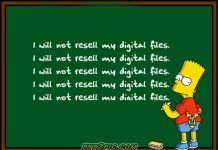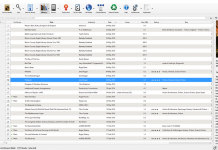 It’s PR like cotton candy — sweet, full of air, and not very nutritious.
It’s PR like cotton candy — sweet, full of air, and not very nutritious.
That’s the latest news release from the International Digital Publishing Forum, extolling its standards development work for the e-book industry.
I wish I could be more upbeat. I know and greatly respect those in IDPF who were probably involved in compiling and drafting the news release.
Publishers and others in the digital publication industry, however, should carefully evaluate the claims in the news release, and weigh different perspectives such as this one. As I’ll say here, the IDPF plan as described in the news release will not tear down the Tower of eBabel. It won’t fully address e-book compatibility issues, regardless of the sugary words.
David Rothman has already provided an excellent summary of his thoughts on the IDPF news release. And the first comment on David’s article, by Richard, hits the nail on the head. It’s obvious that many who follow the e-book industry do not share the claims and enthusiasm of the IDPF news release.
This article will expand upon what David and Richard wrote, add some new thoughts, and, unlike the IDPF news release, will be specific and substantive without the marketing “fluff.” In addition, I’ll describe what we believe is a better solution, available today, for publishers and others: the OpenReader Publication Format, and call for IDPF to move its standards work to OASIS.
No, this won’t be as sweet-tasting as the IDPF confection, but the idea here is to inform you, not just tease your taste buds with fluffy cotton candy.
Credit IDPF where credit is due
To start off, we at OpenReader applaud IDPF for its renewed interest in standards, such as its soon-to-be-released Container Specification (PDF alert), and the planned OEBPS update (the “next OEBPS.”) In fact, OpenReader plans its container to be compatible with the IDPF Container.
Lee Passey, who is assisting and advising OpenReader with its format development, and yours truly, significantly contributed to the IDPF Container development effort (Lee’s contributions were brilliant!) In addition, I’m currently participating as an invited expert (I prefer to call myself an “invited contributor”) to the OEBPS Working Group (“OEBPS WG”) and have contributed my share to the discussion.
This is mentioned to show OpenReader’s commitment to open standards and to collaboratively work with other standards organizations for mutual goals, even if we disagree in other areas.
But as noted in the introduction, the news release by IDPF does not paint a completely accurate picture of the real role the IDPF Container plays in the digital publication “ecosystem,” and creates a false sense that it, along with the “next-generation OEBPS” comment (which itself is misleading, more below), will solve the “Tower of eBabel” and thereby lead the digital publication industry out of the wilderness and towards some sort of Nirvana. It won’t — not by a long-shot.
Specific issues with the IDPF news release
There’s several issues I have regarding the IDPF news release. To keep this article from getting too long, I’ll focus on three of them. (Alert: fairly technical in spots.)
-
The IDPF Container is simply a tweaked version of the container spec portion of the Open Office Open Document Format (PDF alert), which in turn is based upon Java JAR and ZIP.
There is little new and innovative in the IDPF Container spec. It’s nothing to crow about, especially in that what makes an e-book and digital publication format is not the container, but what’s inside the container — the cream-filled center as we like to say.
-
The IDPF Container does not solve the issue of the “Tower of eBabel” since what creates the Tower are the incompatible formats themselves. Simply containing a bunch of different proprietary formats does not solve much of anything — it does not make these incompatible formats any more compatible with each other.
When you put apples and oranges in a barrel, you still have apples and oranges — they don’t magically morph into “orapples”.
Certainly, the DRM side of this coin might be resolved if the vendors of the various proprietary formats (such as Amazon/Mobipocket, Adobe, and Microsoft, to name three) are willing to shift their own proprietary DRM systems to some common, consortium-managed or truly interoperable DRM system applied at the Container level. What’s the odds of that happening soon? All I see is a mess which won’t make life much easier for publishers, retailers and end-users. It’ll just add to the babble.
Now to be blunt: Just as it has been the last few years, I don’t see IDPF truly interested in promoting a single, open, universal, consumer-level digital publication format standard, along with a single, industry-managed, consumer-friendly DRM standard. IDPF must believe by focusing on this “open” Container standard, which can contain a bunch of proprietary formats, and slip in OEBPS through the “back door,” that they can convince the world they are promoting a single universal open standard, but I simply see it as smoke and mirrors.
-
The news release specifically notes that the OEBPS format specification update being worked on by IDPF is “next-generation.” But this is a marketing statement that is not accurate and which, as I see it, is misleading. The scope of the next OEBPS is not “next-generation,” but simply a minor tweak. A version 1.3 or a version 1.5 is not next-generation. A “next-generation” would be a version 2.0 where everything is “new and improved,” like what was being proposed for OEBPS 2.0 in 2003 before that effort withered on the vine due to the “we-have-all-the-standards-we-need” attitude of the IDPF (then OeBF) leadership at the time.
Most importantly, and unfortunately, the next OEBPS as it is currently chartered does not plan to address all the well-established important issues and requirements of publishers, distributors and retailers, librarians/archivists, the accessibility community, and end-users. Instead the OEBPS WG is mostly focusing on lower-priority items such as SVG and embedded fonts (fortunately they are considering navigation, an important accessibility requirement, but that required some lobbying to even get that considered as important.)
The next OEBPS doesn’t tackle head-on a few important issues that should be given priority and implemented as soon as possible. The priorities of the OEBPS WG as it is currently chartered, which I faithfully contribute to as an invited expert, are backwards.
Important Issue: Interactivity, annotation and inter-publication linking
So what are the important issues IDPF should be working on, particularly with regards to the “next OEBPS”? Keeping this article from becoming a book does not permit me to delve into all of them.
But let me note an important one: The ability to deep link into and between digital publications. This ability also enables other types of interactivity with publications, such as annotation, book marking, social networking, etc., etc., which rely upon the same pointing mechanism and fundamental underlying architecture of the format. (Hereafter I’ll simply refer to this as “interactivity.”)
Interactivity with digital publications of all kinds (including e-books) is fast becoming very important to our digital future. Witness the rise of blogs, annotation systems, and various social/collaborative online environments such as the Wikipedia. And with good reason as David Rothman and others have recently written about many times in the TeleRead blog — it is natural, once the capability is enabled as web technologies do, for people to want to interact with digital content, and with each other via the content, in ways not possible with ink-on-paper content.
In fact, this blog article is an example of the power of interactivity with digital content; not only does this article link to other content to comment upon it, others will likely link to and comment upon this article. It is thus important that the formats used to represent and deliver digital publications themselves be “interactivity ready.” so they may seamlessly interface with interactivity systems. After accessibility, interactivity with the world-at-large must be next in priority in the design of digital publication formats for the future.
Unfortunately, the current OEBPS — and likely the OEBPS upgrade — is deficient in a few areas that are solvable only by going to a true next-generation version as was planned a few years ago. This requires some major architectural changes, not just a couple band-aids applied here and there while keeping the current OEBPS paradigm intact.
Interestingly, in 2003 a lot of discussion took place in PSWG (the working group I participated in that developed and maintained OEBPS until recently) about how to architecture the next-generation OEBPS for our interactive future. This discussion considered how to enable linking into OEBPS Publications — the role of identifiers, document addressing, and resource naming were recognized as particular areas needing resolution. Important driving factors include, among others, the publishing work flow, distribution and retail considerations, reading system implementation, and reducing the brittleness of links, especially given the penchant of some publishers to not do the right thing in preparing and updating their publications, and in proper assignment of identifiers. In short, it is not a trivial problem, and requires a comprehensive, holistic solution. Band-aids are not sufficient.
The OpenReader format is the “next-generation” and enables interactivity
 The OpenReader Publication Format, unlike the current OEBPS 1.2 and the “next OEBPS” as chartered, is truly “next-generation.” Its fundamental architecture is designed from the ground-up for interactivity. It also enables all the original “OEBPS 2.0” features and functions asked for the last few years by the many stakeholders in the digital publication universe, including publishers, plus a few more based on developments the last three years. (For a partial glimpse into the feature set, refer to the recent OpenReader Binder milestone article.)
The OpenReader Publication Format, unlike the current OEBPS 1.2 and the “next OEBPS” as chartered, is truly “next-generation.” Its fundamental architecture is designed from the ground-up for interactivity. It also enables all the original “OEBPS 2.0” features and functions asked for the last few years by the many stakeholders in the digital publication universe, including publishers, plus a few more based on developments the last three years. (For a partial glimpse into the feature set, refer to the recent OpenReader Binder milestone article.)
And most importantly, the OpenReader format is here now, essentially ready to be implemented. While IDPF is slowly tweaking the current OEBPS paradigm — and focusing on lower priority bells and whistles like embedded fonts and SVG rather than focusing on the fundamental architecture to fully enable the potential of our digital publishing future — the OpenReader format has moved ahead to the “next-generation,” ready to meet publisher’s needs today, and into the future. We look forward to OSoft’s implementation of OpenReader in its open source dotReader, and others who plan to follow. We are making behind-the-scenes progress on several fronts. Any company or organization reading this that is interested in supporting the OpenReader Publication Format in some capacity, let me know.
A call for all publication format standards work to move to OASIS
Of course, IDPF is welcome to embrace the OpenReader format standard, and we are willing to merge our interests with IDPF and other organizations such as DAISY, in the appropriate neutral standards forum, such as OASIS. Imagine how much more OEBPS/OpenReader would be regarded and embraced if the standards are developed in OASIS, to stand along side other important OASIS digital publication standards, such as the Open Document Format, DocBook, and DITA. That’s pretty good company!
Why IDPF has chosen to conduct all digital publication-related standards work internally, especially given its spotty history in the standards area, while the real action in the digital publication universe is taking place at OASIS, mystifies me. OpenReader has been unfairly accused of forking and splintering the effort at e-book and digital publication standards, but, like the proverbial finger when pointed at someone else, there are three more fingers pointing backwards towards the accuser.
Unlike IDPF up to now, the goal of the OpenReader Consortium is to move our standards effort to a standards umbrella group such as OASIS because it is the right thing to do. I hope that IDPF will likewise do what’s right for all its member organizations and move its standards activities to OASIS, and leverage the many resources OASIS offers, as well as working more closely with other standards efforts in the digital publishing arena (the “neutral” ground of OASIS is conducive to this collaboration.)
This will allow IDPF to focus its activities and resources on building itself as a potent trade organization in the digital publishing arena, which seems to be the first-love of many of the IDPF leaders and members. With the limited resources IDPF has, it cannot excel in being both a trade organization and a standards organization.
(Time stamp changed from 9:26 p.m. June 16 to keep this post near the top of the TeleBlog. — DR)

































Jon,
To address just one of your points. I totally agree that the publishing industry should maximize leverage from groups like OASIS: I sponsored the recent IDPF Board decision to join OASIS as an institutional member. I feel industry-specific organizations like IDPF should minimize de nova standards development and leverage broader IT standards as much as possible, as we are doing with OEBPS (based on XHTML and CSS) and OCF (based on ODF’s packaging).
That being said, it’s naive to expect that broad-based IT standards groups will successfully accomplish everything required for particular vertical industries. For example, the priorities of commercial digital publishing may not match the priorities of the broader membership of a group like W3C or OASIS. Thus successful industry organizations like OMA (Open Mobile Alliance) retain the capability to create industry-specific standards, even though they prefer not to do so. That’s what we’re balancing in IDPF, and it seems like it’s working well.
Calling for “all publication format standards work to move to OASIS” is about as practical as calling for “all law-making work to move to the Federal Government”. I tried to get an Act of Congress to lower the speed limit on my street, but that didn’t work out so well.
As far as “neutrality” – the IDPF’s membership appears to be at lesat as broad-based, within our industry, as the membership of OASIS. If anything, groups like OASIS and W3C tend to be more vendor-driven, whereas IDPF includes more publisher and etailer leadership which increases neutrality.
Bill, I appreciate your comments.
Calling OASIS a broad-based IT standards group is incorrect. Perusing the various technical committees there, it is clear that OASIS is a very good neutral umbrella for doing all kinds of standards work. The Open Document Format chose OASIS for a reason, as did DocBook. Now one could claim that ODF and DocBook are “IT-standards”, but that’s really not correct, especially for ODF, a standard which may be used for publishing, for business, and for technology — a whole range of vertical markets which are definitely in the digital publishing arena. Some in the ODF crowd have even discussed using ODF for distributable digital publications, which I have some difficulties with, but it does demonstrate that ODF is not considered by its proponents to be an “IT-standard”, but definitely intersects with the digital publication world in multiple ways.
OASIS has a huge number of member organizations, is neutral, and pretty much lets anyone set up standards work there so long as they get the minimum number of sponsors. They even support competing standards. What OASIS provides is a structured, but not over-structured environment to conduct standards work, and it forces full openness (which IDPF has yet to achieve.)
[…] Analysis of Open Container Format by Jon Noring […]